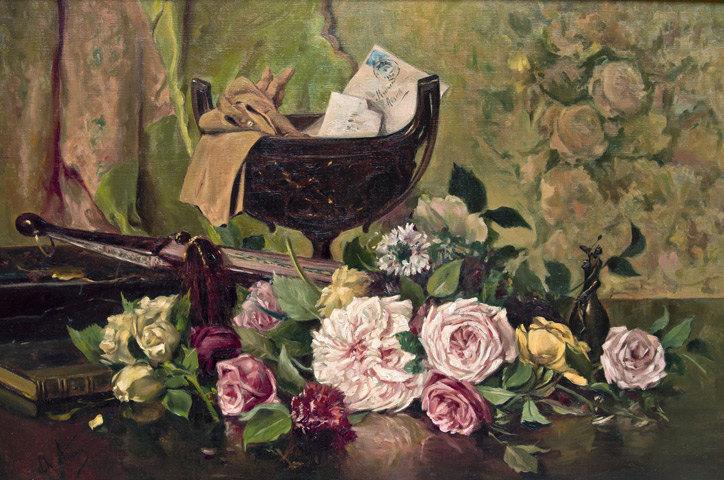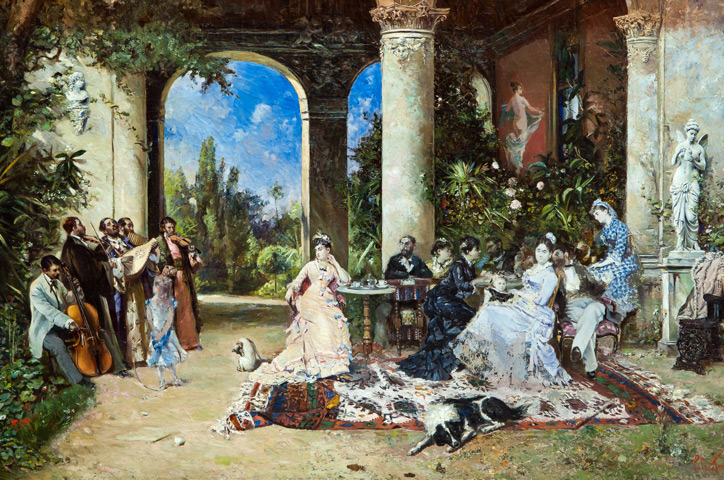Discover the works in the Romanian Modern Art Gallery
Baba - The Chess Player
Corneliu Baba chose The Chess Player to make his debut at the official 1948 Bucharest Art Salon.
In the corner of the artist’s studio a man in his 50s sits bent over a chess board, his hands resting on his knees. From his attitude and posture we can tell he is deeply engrossed in the move underway, most likely a black knight’s attack over a white pawn. These are two of the seven pieces we can see on the board. The close-range, steep angle view is particularly intriguing: the painter (Baba was a tall, well-built man) is also the invisible partner in this chess game. He alone can run the narrow line between inside and outside, between an active player and an attentive observer.
Read more: Baba - The Chess Player
- Artwork description
- Corneliu Baba
(Craiova, 1906 - Bucharest, 1997)
Oil on canvas
100,8 cm x 93 cm - Artwork location
- Romanian Modern Art Gallery, room 11
Andreescu - Rocks and Birch Trees
Rocks and Birch Trees is a highly emblematic painting for Romanian landscape painting in the latter quarter of the 19th century. It reveals Andreescu’s wish to catch up with contemporary European developments, as artists’ interest shifts from representing a particular place or motif toward visual construction, colour relationships and the interplay of light and shadow.
The reddish-brown foliage and the coloured greys of the rocks alternate with the dominant blue sky against which rise the majestic crowns of the birch trees. Colour sensations are spectacularly transposed onto the canvas by Andreescu, whose fresh brushwork naturally blends light into colour. This is the lesson he learned at Fontainebleau while working side by side with painters who, like their predecessors Jean-François Millet and Théodore Rousseau, had gradually come to master the technique of working in the open air, free of all formal solemnity.
Read more: Andreescu - Rocks and Birch Trees
- Artwork description
- Ioan Andreescu
(Bucharest, 1850 - 1882)
Oil on canvas
6 x 46,5 cm
Inv. 2726 - Artwork location
- Romanian Modern Art Gallery, room 2
Aman - Flowers (Still-life)
A simple still-life with roses, one is tempted to say. And yet as soon as we notice the fan, books, perfume bottle, and the metal bowl containing notes, letters and an elegant pair of beige leather gloves next to the flowers, we understand there is more to it than meets the eye. The artist spells out a visual riddle. Each element plays a part in portraying an invisible but highly elegant, refined person. Certainly the riddle is about a woman who loves flowers, particularly pink roses, but who would she be? Looking closer we discover that the envelope in the bowl is addressed to Madame Aman...
Ana Aman, the painter’s wife, was a highly educated and fashion-conscious lady. The painting is nothing short of a love-letter. Though absent from the painting, and perhaps from home, she is always present in the artist’s thoughts.
Roses in the painting go a long way back, reviving a tradition of associated symbols. These range from Christian symbols as in religious paintings of the Virgin, such as Domenico Veneziano’s “Virgin and Child” in the Gallery of European Art, to more mundane, Biedermeier paintings, such as Smaranda Catargi’s lavish engagement portrait at the mezzanine of the National Gallery.
Read more: Aman - Flowers (Still-life)
- Artwork description
- Theodor Aman
(Câmpulung Muscel, 1831 – Bucharest, 1891)
Oil on canvas
48,5 x 75,5 cm
Inv. 3181 - Artwork location
- Romanian Modern Art Gallery, room 1
- Sign language video
- Sign language video
Aman - Party with Musicians
More than a family portrait or an episode in the visual chronicle of Bucharest high society in the 1880s, Party with Musicians is a statement of modernity.
The painting depicts a family gathering that takes place in the family’s home garden, be it real or imaginary. Brothers, friends and in-laws are engaged in light, after-noon conversations while nephews and nieces play around, listening to the music of a traditional band. French fashion rules among family members: women’s mostly lightly-coloured summer dresses display tight bodices and skirts with ample tails at the back, while men’s costumes consist of black coats and light trousers. Musicians are dressed in loose fitting, long, ample, caftan-like vestments remindful of the way local boyars used to dress half a century earlier. Only the cellist wears a Western-style costume, the sign he is schooled musician.
Everyone is relaxed. Take for instance Zina de Norÿ, Aman’s stepdaughter and an opera singer of international reputation who is sitting casually on the base of a column to the right of the painting. Surrounded by the family, Ana, the painter’s wife, is the only one to look straight to us.
Following in the footsteps of Impressionist painters like Monet, Bazille or James Tissot, Aman uses his family and friends to explore the contemporary local lifestyle without any constraints, his paintings a genuine pictorial chronicle of the local highlife. Other paintings on display in the gallery such as On the Terrace at Sinaia, View from Câmpulung, Soirée (Ball in the Studio) also reflect Aman’s approach and his genuine interest to stay in touch with European artistic developments.
Read more: Aman - Party with Musicians
- Artwork description
- Theodor Aman
(Câmpulung Muscel, 1831 – Bucharest, 1891)
Oil on canvas
51 x 90 cm
Inv. 3617 - Artwork location
- Romanian Modern Art Gallery, room 1






